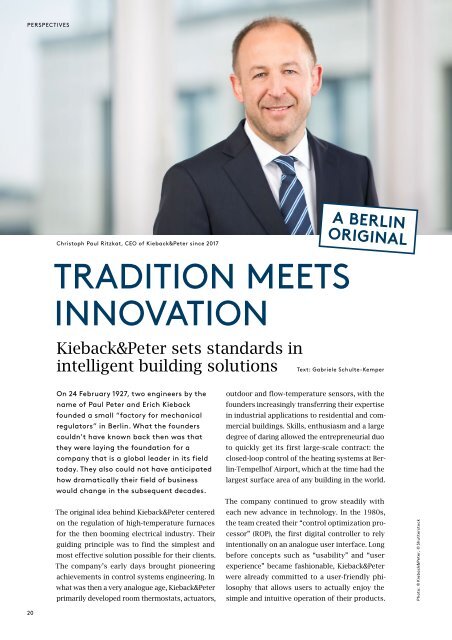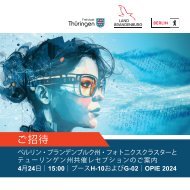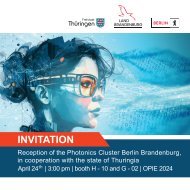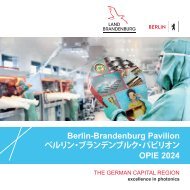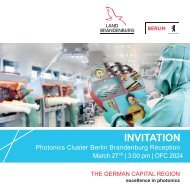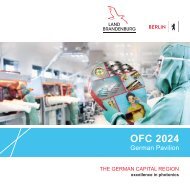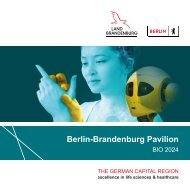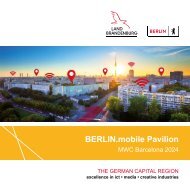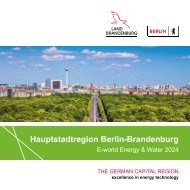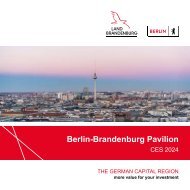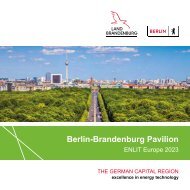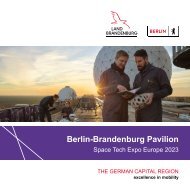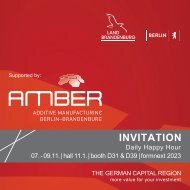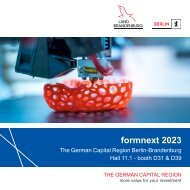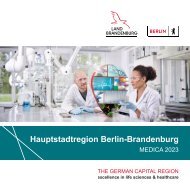Berlin to go, english edition, 02/2019
Create successful ePaper yourself
Turn your PDF publications into a flip-book with our unique Google optimized e-Paper software.
PERSPECTIVES<br />
Chris<strong>to</strong>ph Paul Ritzkat, CEO of Kieback&Peter since 2017<br />
A BERLIN<br />
ORIGINAL<br />
TRADITION MEETS<br />
INNOVATION<br />
Kieback&Peter sets standards in<br />
intelligent building solutions Text: Gabriele Schulte-Kemper<br />
On 24 February 1927, two engineers by the<br />
name of Paul Peter and Erich Kieback<br />
founded a small “fac<strong>to</strong>ry for mechanical<br />
regula<strong>to</strong>rs” in <strong>Berlin</strong>. What the founders<br />
couldn’t have known back then was that<br />
they were laying the foundation for a<br />
company that is a global leader in its field<br />
<strong>to</strong>day. They also could not have anticipated<br />
how dramatically their field of business<br />
would change in the subsequent decades.<br />
The original idea behind Kieback&Peter centered<br />
on the regulation of high-temperature furnaces<br />
for the then booming electrical industry. Their<br />
guiding principle was <strong>to</strong> find the simplest and<br />
most effective solution possible for their clients.<br />
The company’s early days brought pioneering<br />
achievements in control systems engineering. In<br />
what was then a very analogue age, Kieback&Peter<br />
primarily developed room thermostats, actua<strong>to</strong>rs,<br />
outdoor and flow-temperature sensors, with the<br />
founders increasingly transferring their expertise<br />
in industrial applications <strong>to</strong> residential and commercial<br />
buildings. Skills, enthusiasm and a large<br />
degree of daring allowed the entrepreneurial duo<br />
<strong>to</strong> quickly get its first large-scale contract: the<br />
closed-loop control of the heating systems at <strong>Berlin</strong>-Tempelhof<br />
Airport, which at the time had the<br />
largest surface area of any building in the world.<br />
The company continued <strong>to</strong> grow steadily with<br />
each new advance in technology. In the 1980s,<br />
the team created their “control optimization processor”<br />
(ROP), the first digital controller <strong>to</strong> rely<br />
intentionally on an analogue user interface. Long<br />
before concepts such as “usability” and “user<br />
experience” became fashionable, Kieback&Peter<br />
were already committed <strong>to</strong> a user-friendly philosophy<br />
that allows users <strong>to</strong> actually enjoy the<br />
simple and intuitive operation of their products.<br />
Pho<strong>to</strong>: © Kieback&Peter, © Shutters<strong>to</strong>ck<br />
20


